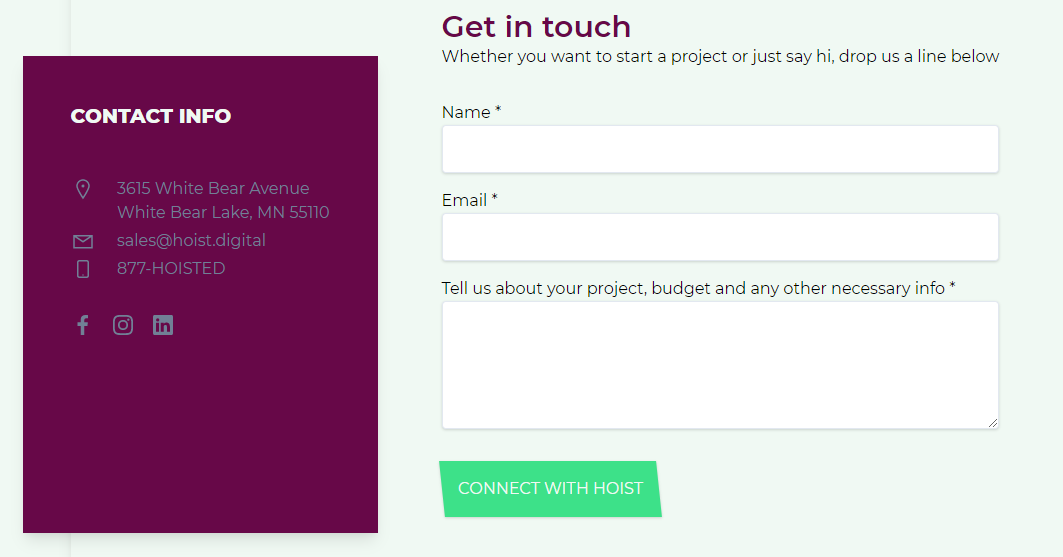
Subscribe to our newsletter!
We don't spam. You will only receive relevant and important tips for you and your business.
Unsubscribe anytime.
In digital marketing, the term landing page is tossed around pretty frequently, however, the actual definition varies depending on where you look.
So, what exactly is a landing page? What makes it unique? Why are landing pages so important?

A landing page is where a user lands when they click on a hyperlink to a website.
Some people (even Google) will tell you that a landing page could be any page that a user lands upon after clicking a link. However, a landing page isn’t just any web page.
In digital marketing, it is an independent web page, created for the purposes of a marketing campaign.
Landing pages can be used to capture visitor’s information in exchange for content such as ebooks, email newsletters, online courses, industry events, free product trials, community memberships, and company mobile apps. Landing pages have one purpose: to generate leads.
Instead of leading consumers to a general homepage, you can direct them to a custom page where your main goal is to prompt visitors to convert.
Your homepage provides consumers with information about your business and your product or service. It also usually has a navigation tab and multiple CTAs. A landing page only presents consumers with the information needed to make a conversion.
This eliminates confusion and the chance of users having a difficult time navigating throughout your website.
A good landing page is focused on one stream of traffic. For example, let's say you work for an HVAC company. If you have an email campaign that is promoting a furnace tune-up, then your landing page should target people who are in need of that service. Because when users click that link in the email, they are showing interest in a furnace tune-up.
Focusing on this particular stream of traffic will help you convert a higher percentage of your website visitors into leads.
A good landing page headline should include the following characteristics:
Clarity: The headline needs to connect with users right away. It should be clear, concise, and to the point.
Relevance: One of the most important requirements for a landing page is that user expectations are met with the message match. This means that when a user clicks on the link for the landing page, the message on the page must be the same message the user sees in the ad.
Empathy: Your headline needs to tell visitors if your business can help them by solving a problem, making their lives easier, or teaching them something new.
The copy on your landing page should support the call-to-action by emphasizing the benefit your business provides consumers.
Each landing page has a single objective: the call-to-action (CTA). The CTA is an invitation for the visitor to take action.
In order to include a CTA, you must have a goal for your landing page. Whether it is to collect email addresses or to encourage users to make a purchase, it needs to be established before you create the page. Your goal will help you to create your CTA.
Everything on the page should support the CTA, from the headlines and body copy to images.
Most of the time, the CTA is either a short form or a click-through button. The form should only require visitors to fill out the most important information, such as an email address. Other CTAs could include inducing a phone call, a text message, or even an e-commerce sale.
How you phrase that CTA will greatly affect how your landing page performs. When crafting a CTA, you are trying to tap into your audience’s emotions in order to convince them to complete the action.

A poor CTA will hurt your lead generation, so you should always conduct A/B testing to determine which phrases resonate with your audience. According to Crazy Egg, every audience responds differently depending on their personalities, desires, pain points, and other characteristics. You can’t just assume that a well-written CTA will resonate with your audience.
Landing pages are created by marketers as a method for collecting leads.
While homepages typically include multiple links, a landing page has very few. The ratio of conversion goals to links should be 1:1. Because a landing page only has one goal, there should only be one link. It has also been reported that having fewer links on the landing page will increase conversion rates.
Because the only goal of a landing page is to get conversions, the design should be as simple as possible with few distractions and copy should be to-the-point and concise.
The easier you make it for users to take action, the more likely you are to get conversions.
There are three main categories of landing pages: standalone, microsites, and internal website landing pages.
Standalone landing pages are separate from your main website, designed specifically for users to click-through to. These landing pages are created for a campaign and are designed around the CTA.
A microsite is a branded independent site that lives outside of the homepage. Microsites have their own URL and contain evergreen content created to support a campaign, so they don’t require frequent updates or maintenance.
Internal website landing pages could consist of any existing page on your website. This will not help to get more conversions unless the page is designed for the sole purpose of collecting leads.
A lead generation landing page uses a lead-capture form to collect lead data such as names or email addresses. This is the primary type of landing page used.

Click-through landing pages have a simple button as a CTA and are typically used for e-commerce.

As you can see in this Google Cloud Platform landing page, visitors are encouraged to click the button to get 12 months of Google Cloud Platform for free.
The headers and body copy both support the CTA by reminding the visitor that signing up is free.
Landing pages are designed for paid traffic. Users can be directed to a landing page via a search engine result, a banner ad, a link in an email, or a print advertisement.
When you look at a Google Search results page, paid search ads will appear at the top of the page. Advertisers can customize the link in which customers are directed to when they click on a paid advertisement. You can choose whether to direct customers to a standalone landing page, or any other page on your website.
However, the organic search results that appear under paid advertisements are populated by Google. Organic traffic may or may not be directed to your homepage, depending on the search query. Organic search results allow users to discover your website, but they may not necessarily be encouraged to make a conversion.
If you'd like to learn more about landing pages